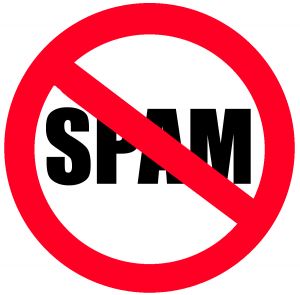A few weeks ago I was explaining text marketing to a local businessman and how people will opt into a text list for some  sort of valuable promotion. He interrupted me to say, “I get enough spam in my email. I don’t want it on my phone too!”
sort of valuable promotion. He interrupted me to say, “I get enough spam in my email. I don’t want it on my phone too!”
“But it’s not spam,” I said.
“It is to spam,” he replied.
I answered more firmly, “Nooo, it is not.”
According to the FTC, spam is unsolicited commercial email, or simply, “junk email messages from people you don’t know”. So technically, if you knowingly opt in or subscribe to the messages you can’t say they were unsolicited or from strangers. However, the term “spam” has come to describe all email that comes in an overly frequent schedule or even just email that the reader doesn’t want to deal with at the time.
I’ve done it before. Subscribed to some retail outlet or some newsletter and then got frustrated with the unread piles that just kept coming. I wanted the deals/information, but was overwhelmed to the point of unsubscribing. Part of it could be my fault for letting email pile up without reading and then going on a massive cleansing. The other part could be that some over zealous, uncaring or clueless marketer thought that hammering their subscriber list with deals was what the people wanted.
Everyone knows what its like to get tons of email they can never find time to read. Even those who send “spam” get bombarded with the stuff themselves. So here are some keys to having your “solicited” email (or text) not get labeled as spam.
Set a schedule and stick to it. And, quite simply, unless you’re Groupon and have daily deals, if I see your email more than once a week, that’s too much. With text this is a little different – especially if you use it as an alert system. You can also use text messaging for coupons, reminders and to prompt action. Try to stay within 2-3 texts per week.
Go value or go home. The day your email or text does not appear valuable to the subscriber is the day they unsubscribe (or they will in short order). Don’t just incentive the giving up of their email or mobile number to be on your VIP list. Follow through to keep them on your list.
Never, ever, EVER buy a list. There will be people who claim that their list is “clean” or that people have knowingly opted in to receive the messages you’re going to send, but don’t buy it. Remember that part about being “unsolicited” and being from “people you don’t know”? Yeah. “SPAM” is written on the foreheads of all the suckers who buy email or text lists.
Real spammers have given a lot of bulk email and texts a bad name. While there are currently no laws on the books to penalize those guilty of the text variety, the fear that one will be bombarded with mobile messages still exists. These are not reasons to flee email or SMS marketing, but simply warnings to do it the right way. If you’re unsure about frequency or how to create your own opt in list, talk to a professional (Ooo! Me! Me!). Doing it the right way offers a win-win scenario for the business and their clients.
